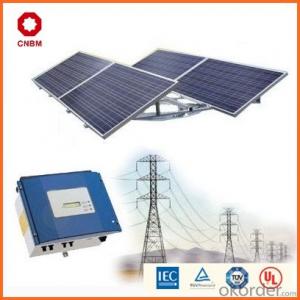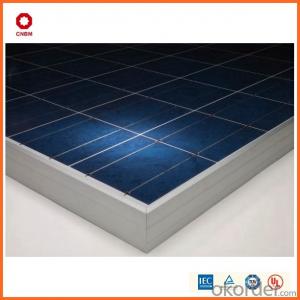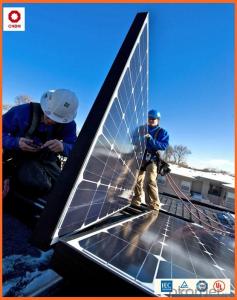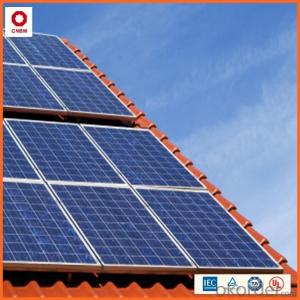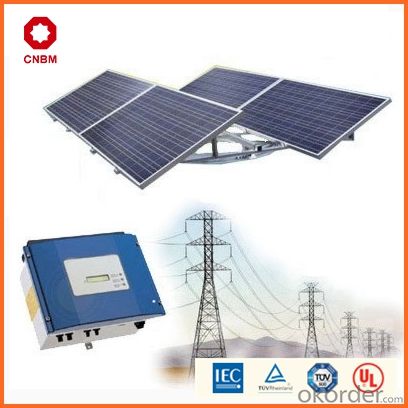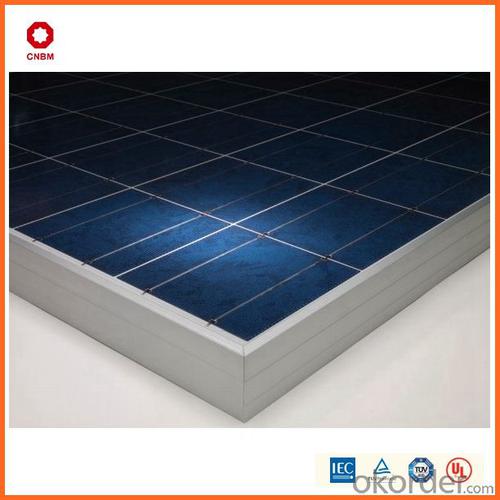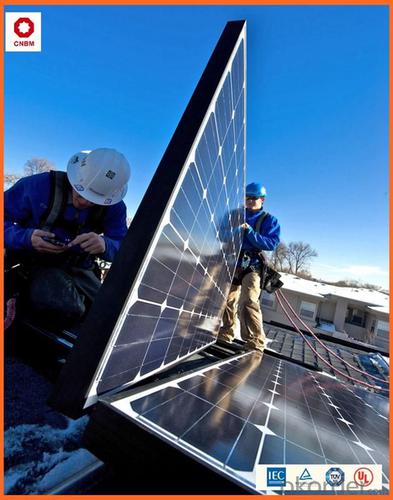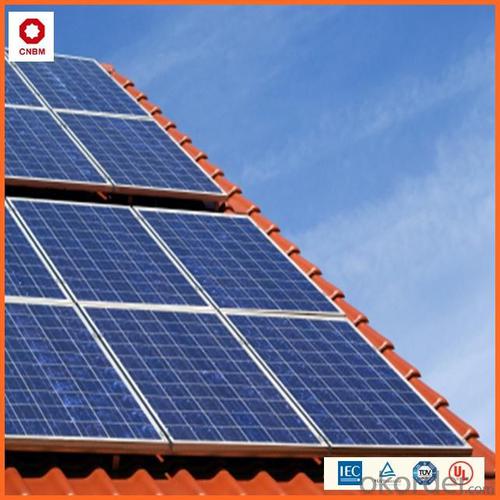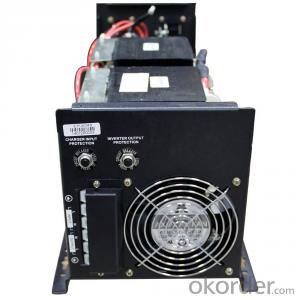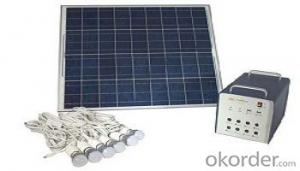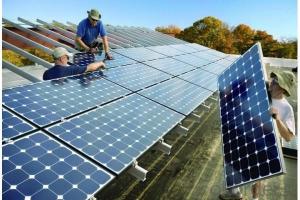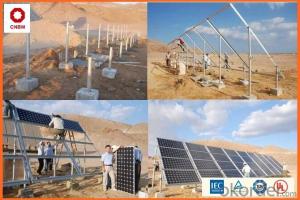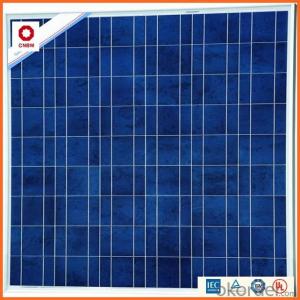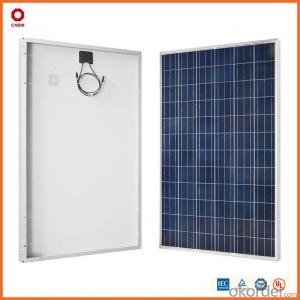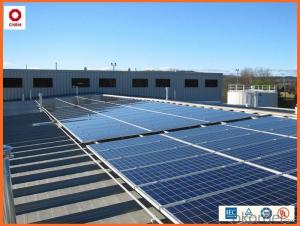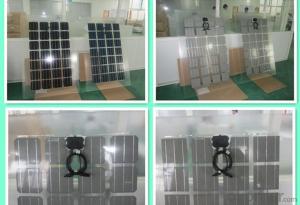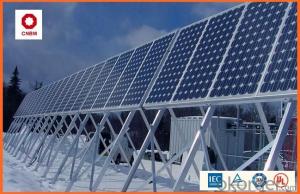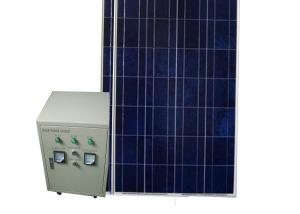Mpi Solar Energy Systems 65w Small Solar Panels in Stock China Manufacturer
- Loading Port:
- China main port
- Payment Terms:
- TT OR LC
- Min Order Qty:
- 1 watt
- Supply Capability:
- 10000000 watt/month
OKorder Service Pledge
OKorder Financial Service
You Might Also Like
Specification
Product Description:
Hot Sale !!! Quality and Safety of Small Poly Solar Panel 5w~150w
1. Rigorous quality control meets the highest international standards.
2. High-transmissivity low-iron tempered glass, strong aluminium frame.
3. Using UV-resistant silicon.
4. IS09001/14001/CE/TUV/UL
Warranties of Small Poly Solar Panel 35~85w
1. 10 years limited product warranty
2. 15 years at 90% of the minimal rated power output
3. 25 years at 80% of the minimal rated power output
Specification
Characteristics of Poly solar panels CNBM (245-320W) | |||||
Max Power Voltage Vmp(V) | 30.3 | 30.8 | 31.1 | 31.4 | 31.85 |
Max Power Current Imp(A) | 7.60 | 7.64 | 7.73 | 7.81 | 7.85 |
Open Circuit Voltage Voc(V) | 36.1 | 36.6 | 37 | 37.3 | 37.68 |
Short Circuit Current Isc(A) | 8.50 | 8.55 | 8.65 | 8.75 | 8.85 |
Max Power Pm(W) | 230W | 235W | 240W | 245W | 250W |
Temperature Coefficient of Cells Poly solar panels CNBM (245-320W) | |
NOCT | 45± 2 |
Temperature Coeffucients of Isc | 0.0492 |
Temperature Coeffucients of Voc | -0.3374 |
Temperature Coeffucients of Voc | -0.4677 |
Mechanical Data of Poly solar panels CNBM (245-320W) | |
Dimension | 1638 × 982 × 40 mm |
Weight | 19.5 kg |
No. of Cells and Connections | 60 (6 ×10) |
Tolerance | 0 ~ + 5 W |
Cell | Monocrystalline Cell 156 × 156 mm |
Packing | 624 Pcs/40ft(H) Container |
Limits of Poly solar panels CNBM (245-320W) | |
Operating Temperature | -40 to +85 |
Storage Temperature | -40 to +85 |
Max System Voltage | 1000VDC(IEC) / 600VDC(UL) |
Features of our products:
• High conversion efficiency mono/poly-crystalline amorphous silicon solar cells
• Modules incorporate high performance bypass diodes to minimize the power drop caused by shading
• High transmittance, low-iron tempered glass
• High performance EVA encapsulant to prevent destroying and water.
• AI frame: without screw, corner connection. 8 holes on the frame can be installed easily
• Good performance of preventing from atrocious weather such as wind and hails
• Certifications: CE IEC TUV VDE UL, Class I
• 10 years 90% power output warranty
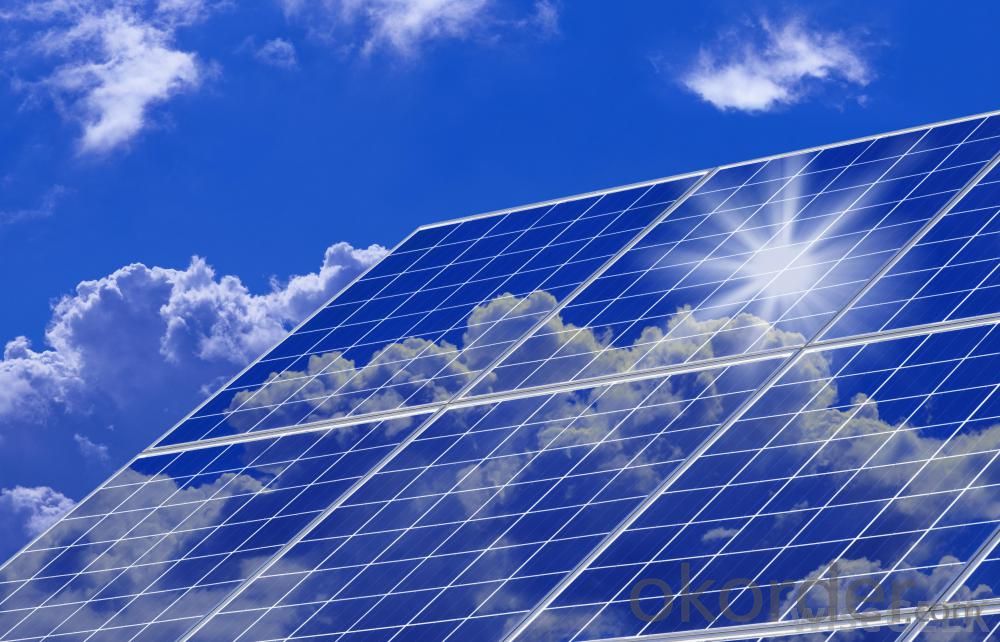
Shipping of Small Poly Solar Panel 35~85w
By Sea | Delivery from Shanghai or Ningbo seaport |
By Air | Departure from Shanghai Pudong Airport |
By Express | Post by DHL, EMS, UPS, TNT. |
Features of our products:
• High conversion efficiency mono/poly-crystalline amorphous silicon solar cells
• Modules incorporate high performance bypass diodes to minimize the power drop caused by shading
• High transmittance, low-iron tempered glass
• High performance EVA encapsulant to prevent destroying and water.
• AI frame: without screw, corner connection. 8 holes on the frame can be installed easily
• Good performance of preventing from atrocious weather such as wind and hails
• Certifications: CE IEC TUV VDE UL, Class I
• 10 years 90% power output warranty
As a professional Solar Panel manufacturer and Supplier in China, we have our customers come around the whole world and our specialization has got a worldwide recognition. Meanwhile, with our superior quality, competitive price, prompt and excellent service, As main role in trade section of CNBM Group, CNBM International Corporation supplies products including Monocrystalline Solar Panel, Polycrystalline Solar Panel ( multicrystalline silicon Solar Panel) have received and enjoyed famous reputation in many countries and regions in the world.
- Q: Can solar energy systems be used in areas with high altitude?
- Yes, solar energy systems can be used in areas with high altitude. In fact, solar panels can be even more effective in such areas due to the increased solar irradiance at higher altitudes. However, it is important to consider factors like temperature, snowfall, and extreme weather conditions that may affect the performance and maintenance of solar energy systems in high altitude areas.
- Q: How long do solar energy systems last?
- Solar energy systems typically have a lifespan of 25 to 30 years, with some components lasting even longer. However, regular maintenance and occasional replacements may be required to ensure optimal performance and efficiency throughout their lifetime.
- Q: What is the role of maximum power point tracking (MPPT) in a solar energy system?
- The role of maximum power point tracking (MPPT) in a solar energy system is to optimize the efficiency and output of the system by continuously tracking and adjusting the operating point of the solar panels to maximize their power output. By ensuring that the solar panels operate at their maximum power point, MPPT enables the system to harvest the maximum amount of energy from the sunlight, resulting in increased overall system performance and improved energy production.
- Q: How does the angle of a solar panel affect its performance in different seasons?
- The performance of a solar panel in different seasons is greatly influenced by its angle. Also known as the tilt or inclination, the angle refers to the position of the solar panel in relation to the ground. Typically, the ideal angle for a solar panel varies depending on the location and time of year. In regions closer to the equator, where the sun is directly overhead all year round, the optimal angle is usually close to 0 degrees (horizontal) or a slight tilt towards the equator. During the summer solstice, when the sun is at its highest point in the sky, a solar panel with the right tilt angle will receive maximum sunlight and perform at its best. This is because the sun's rays are more perpendicular to the panel's surface, resulting in greater absorption of solar energy. On the other hand, during the winter solstice, the sun is at a lower angle in the sky, causing less direct sunlight. In this situation, a solar panel with a steeper tilt angle can capture more sunlight by aligning itself more closely with the sun's rays. By adjusting the angle to be more vertical, the panel can maximize its exposure to sunlight and maintain a higher level of performance. In regions with distinct seasonal changes, it can be advantageous to use an adjustable mounting system that allows for the optimization of the solar panel's angle throughout the year. This allows the panel to be tilted towards the ideal angle for each season, resulting in consistent and efficient energy generation. However, it's essential to consider that the angle is just one of many factors that affect the performance of a solar panel. Other factors, such as weather conditions, shading, and the efficiency of the solar cells, also play a significant role. Therefore, when designing an effective solar power system, the angle should be taken into account alongside these other parameters.
- Q: Can solar energy systems be used for powering off-grid eco-retirement communities?
- Yes, solar energy systems can definitely be used for powering off-grid eco-retirement communities. Solar power is a reliable and sustainable source of energy that can provide electricity for various needs, such as lighting, heating, cooling, and powering appliances. By installing solar panels and utilizing energy storage systems, off-grid eco-retirement communities can reduce their reliance on traditional power grids and minimize their carbon footprint. This not only helps in achieving energy independence but also promotes a greener and more sustainable lifestyle for the residents.
- Q: How do solar energy systems affect air pollution?
- Solar energy systems have a positive impact on air pollution as they generate clean and renewable energy without emitting harmful pollutants or greenhouse gases. By reducing the reliance on fossil fuels for electricity generation, solar energy helps to improve air quality and mitigate the negative health and environmental effects associated with air pollution.
- Q: How do solar energy systems impact water quality?
- Solar energy systems have a positive impact on water quality as they do not produce any harmful pollutants or emissions during operation. Unlike traditional fossil fuel sources, solar energy does not require water for cooling or produce any wastewater, reducing the risk of water contamination. This makes solar energy systems a sustainable and environmentally-friendly option that helps to preserve and maintain water quality.
- Q: How do I maintain a solar energy system?
- To maintain a solar energy system, regular cleaning and inspection of the panels is crucial. Remove any debris or dirt that may obstruct sunlight absorption. Additionally, check the wiring and connections periodically to ensure they are secure and free from damage. Monitor the system's performance and keep track of any changes in energy production. Lastly, it is advisable to schedule professional maintenance once or twice a year to address any potential issues and optimize the system's efficiency.
- Q: Can a solar energy system be installed in an area with heavy snowfall?
- Yes, a solar energy system can be installed in an area with heavy snowfall. However, it is important to consider certain factors. Snow can reduce the efficiency of solar panels by blocking sunlight, so the panels should be angled properly to allow snow to slide off easily. Additionally, regular snow removal and maintenance may be required to ensure optimal performance during the winter months.
- Q: Can solar energy systems be used for powering off-grid research facilities?
- Yes, solar energy systems can definitely be used to power off-grid research facilities. Solar panels can generate electricity by capturing the sun's energy, which can then be stored in batteries for later use. This makes solar power a reliable and sustainable option for off-grid research facilities, providing a constant source of electricity without the need for traditional power grids. Additionally, solar energy systems can be easily installed in remote areas, making it an ideal choice for powering research facilities located in off-grid or isolated locations.
Send your message to us
Mpi Solar Energy Systems 65w Small Solar Panels in Stock China Manufacturer
- Loading Port:
- China main port
- Payment Terms:
- TT OR LC
- Min Order Qty:
- 1 watt
- Supply Capability:
- 10000000 watt/month
OKorder Service Pledge
OKorder Financial Service
Similar products
Hot products
Hot Searches
Related keywords
